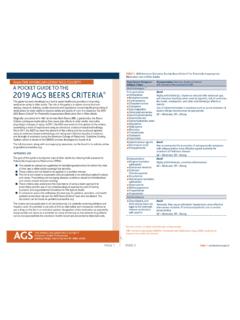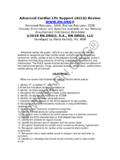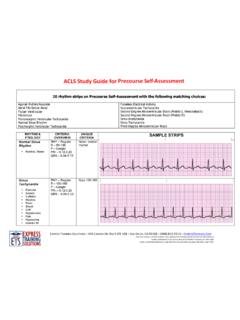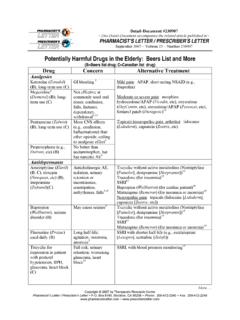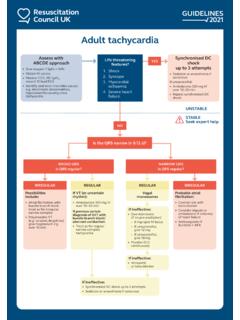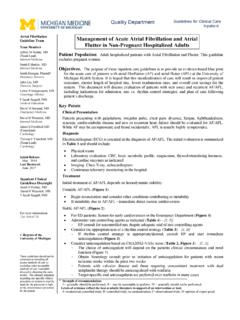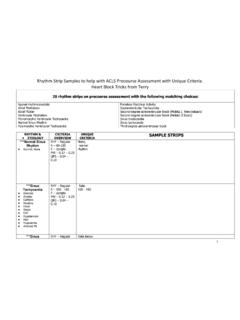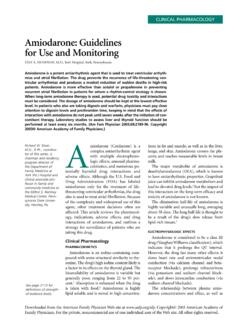Transcription of Summary Product Characteristics - SIMDAX
1 Summary Product Characteristics1. Name of the mediCiNal ProduCtSimdax mg/ml concentrate for solution for Qualitative aNd QuaNtitative ComPoSitioNEach ml of concentrate contains mg of 5 ml vial contains mg of levosimendan. One 10 ml vial contains 25 mg of a full list of excipients, see section PharmaCeutiCal formConcentrate for solution for infusion. The concentrate is a clear yellow or orange solution for dilution prior to ad CliNiCal Therapeutic indicationsSimdax is indicated for the short term treatment of acutely decompensated severe chronic heart failure (ADHF) in situations where conventional therapy is not sufficient, and in cases where inotropic support is considered appropriate (see section ).
2 Posology and method of administrationSimdax is for in hospital use only. It should be administered in a hospital setting where adequate monitoring facilities and expertise with the use of inotropic agents are of administrationSimdax is to be diluted prior to administration (see section ).The infusion is for intravenous use only and can be administered by the peri pheral or central dose and duration of treatment should be individualised according to the patient s clinical condition and treatment should be initiated with a loading dose of 6 12 microgram/kg infused over 10 minutes followed by a continuous infusion of microgram/kg/min (see section ). The lower loading dose of 6 microgram/kg is recommen ded for patients on concomitant intravenous vasodilators or inotropes or both at the start of the infusion.
3 Higher loading doses within this range will produce a stronger haemodynamic response but may be associated with a transient increased incidence of adverse reactions. The response of the patient should be assessed with the loading dose or within 30 to 60 minutes of dose adjustment and as clinically indicated If the response is deemed excessive (hypotension, tachycardia), the rate of the infusion may be decreased to microgram/kg/min or discontinued (see section ). If the initial dose is tolerated and an increased haemodynamic effect is required, the rate of the infusion can be increased to microgram/kg/min. The recommended duration of infusion in patients with acute decompensation of severe chronic heart failure is 24 hours.
4 No signs of development of tolerance or rebound phenomena have been observed following discontinuation of SIMDAX infusion. Haemodynamic effects persist for at least 24 hours and may be seen up to 9 days after discontinuation of a 24 hour infusion (see section ).Experience of repeated administration of SIMDAX is limited. Experience with concomitant use of vasoactive agents, including inotropic agents (except di goxin) is limited In the REVIVE programme, a lower loading dose (6 micrograms/kg) was administered with baseline concomitant vasoactive agents (see sections , and ).Monitoring of treatmentConsistent with current medical practice, ECG, blood pressure and heart rate must be monitored during treatment and the urine output measured.
5 Moni toring of these parameters for at least 3 days after the end of infusion or until the patient is clinically stable is recommended (see section ). In patients with mild to moderate renal or mild to moderate hepatic impairment monitoring is recommended for at least 5 dose adjustment is required for elderly impairmentSimdax must be used with caution in patients with mild to moderate renal im pairment. SIMDAX should not be used in patients with severe renal impairment (creatinine clearance <30 ml/min) (see sections , and ).Hepatic impairmentSimdax must be used with caution in patients with mild to moderate hepatic impairment although no dose adjustment appears necessary for these patients.
6 SIMDAX should not be used in patients with severe hepatic impairment (see sec tion , and ). ChildrenSimdax should not be administered to children and adolescents under 18 years of age (see sections and ).The following table provides detailed infusion rates for both the loading and maintenance infusion doses of a mg/ml preparation of SIMDAX infusion:Patient s weight (kg)Loading dose is given as an infusion over 10 minutes with the infusion rate (ml/h) belowContinuous infusion rate (ml/h)Loading dose 6 microgram/kgLoading dose 12 microgram/ microgram/ microgram/kg/minute402958251050367236126 0438647147050101481780581155101990651305 11221007214 46122411079158713261208617371429 The following table provides detailed infusion rates for both the loading and maintenance infusion doses for a mg/ml preparation of SIMDAX infusion.
7 Patient s weight (kg)Loading dose is given as an infusion over 10 min with the infusion rate (ml/h) below Continuous infusion rate (ml/h)Loading dose 6 microgram/kgLoading dose 12 microgram/ microgram/ micro gram/kg/minute405811551019507214 4612246086173714297010120281734801152301 019389013025911224310014 ContraindicationsHypersensitivity to levosimendan or to any of the excipients. Severe hypotension and tachycardia (see sections and ). Significant mechanical obstructions affecting ventricular filling or outflow or both. Severe renal impairment (creatinine clearance <30 ml/min) and severe hepatic impair ment. History of Torsades de Special warnings and special precautions for useAn initial haemodynamic effect of levosimendan may be a decrease in systolic and diastolic blood pressure, therefore, levosimendan should be used with caution in patients with low baseline systolic or diastolic blood pressure or those at risk for a hypotensive episode.
8 More conservative dosing regimens are recommended for these patients. Physicians should tailor the dose and duration of therapy to the condition and response of the patient (see sections , and ). Severe hypovolaemia should be corrected prior to levosimendan infusion. If excessive changes in blood pressure or heart rate are observed, the rate of infusion should be reduced or the infusion exact duration of all haemodynamic effects has not been determined, however, the haemodynamic effects, generally last for 7 10 days. This is partly due to the presence of active metabolites, which reach their maximum plasma concentrations about 48 hours after the infusion has been stopped. Non inva sive monitoring for at least 4 5 days after the end of infusion is recommended.
9 Monitoring is recommended to continue until the blood pressure reduction has reached its maximum and the blood pressure starts to increase again, and may need to be longer than 5 days if there are any signs of continuing blood p ressure decrease, but can be shorter than 5 days if the patient is clinically stable. In patients with mild to moderate renal or mild to moderate hepatic impairment an extended period of monitoring maybe should be used cautiously in patients with mild to moderate renal im pairment. Limited data on the elimination of the active metabolites are available in patients with impaired renal function. Impaired renal function may lead to increased concentrations of the active metabolites, which may result in a more pronounced and prolonged haemodynamic effect (see section ).
10 SIMDAX should be used cautiously in patients with mild to moderate hepatic impairment. Impaired hepatic function may lead to prolonged exposure to the active metabolites, which may result in a more pronounced and prolonged haemodynamic effect (see section ). SIMDAX infusion may cause a decrease in serum potassium concentration. Thus, low serum potassium concentrations should be corrected prior to the adminis tration of SIMDAX and serum potassium should be monitored during treatment. As with other medicinal products for heart failure, infusions of SIMDAX may be accompanied by decreases in haemoglobin and haematocrit and caution should be exercised in patients with ischaemic cardiovascular disease and concurrent infusion should be used cautiously in patients with tachycardia atrial fibrillation with rapid ventricular response or potentially life threatening arrhythmia s.
